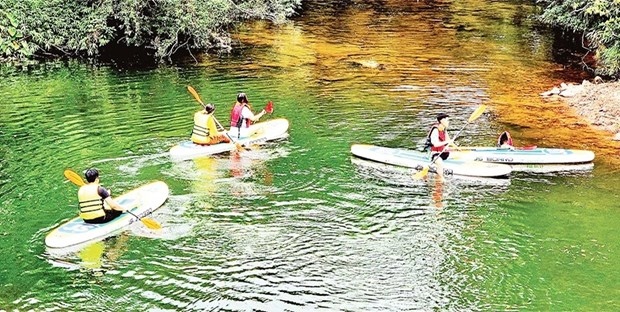Quang Ninh leverages traditional culture for tourism expansion
The northern border province of Quang Ninh, home to UNESCO-recognised World Natural Heritage Site Ha Long Bay, plans to promote traditional cultural tourism in order to attract more tourists.

The province not only has abundant natural resources but also possesses many traditional cultural heritages with unique value. It is a system of relics, rich landscapes, friendly people, unique cuisine, and diverse culture from island waters to ethnic minority areas. All these traditional cultural values give Quang Ninh advantages that not all localities have.
The highland commune of Ky Thuong, Ha Long city boasts rich natural tourism resources, with many high mountain ranges, rivers, lakes, streams, waterfalls, and vast green forests. This is also one of the favourite destinations of visitors because of the picturesque natural scenery and fresh air.
In addition, the traditional cultural values of the local ethnic minorities are also exploited in parallel with ecological values, becoming unique tourism products.
The Ky Thuong Am Vap farm tourist area is designed with wooden stilts with an area of nearly 2,000 sq.m. After immersing themselves in nature, visitors are welcomed by local ethnic people in the traditional Dao ethic costumes. Tourists will also have a chance to visit a community house where costumes and agricultural tools are displayed as well as learn about indigenous culture and brocade embroidery.
The Dao Thanh Y cultural reserve zone in Bang Ca commune is also an attractive indigenous cultural tourism destination in Ha Long city. It preserves the unique cultural values of the Dao Thanh Y ethnic group and is a place for community cultural activities, helping to promote bonds and spread the cultural beauties of the indigenous Dao people.
Recently, some tour operators have started taking tourists to the sanctuary. Binh Lieu mountainous district currently has three provincial relic sites including the Luc Na historical and cultural relic site, the Khe Vanh waterfall, and the terraced fields of Luc Hanh commune. Along with that, many customs and festivals are preserved and handed down such as the Luc Na festival, the Soóng festival of San Chi ethnic group, and the traditional festival of the Dao ethnic group.
In recent years, several festivals such as the “so” flower and golden season festivals, the culture and sports festival of Binh Lieu district have been organised, associating the tourism development policy of the district with a series of unique cultural activities, contributing to promoting and creating opportunities for tourists to experience and explore the natural beauty of the border area.
Optimising cultural resources for tourism development has become a right direction of Binh Lieu, gradually forming strong tourism products such as ecotourism, community tourism, discovery-experience tourism, and border travel, affirming the brand of a new and attractive destination on the Vietnam tourism map.
Deputy Director of Binh Lieu district’s communications and culture centre To Dinh Hieu shared that the district has determined that culture is a strength and a pillar for tourism development. In the recent times, the district has been researching, collecting and restoring traditional cultural rituals that are facing risk of falling into oblivion. The locality has also coordinated with the Hanoi Tourism Co. Ltd. to design tourism products that are both unique and close to tourists.
Besides Yen Duc village in Dong Trieu, Quang Ninh has several cultural villages in Ha Long, Quang Yen, Binh Lieu, Ba Cha, Hai Ha, Mong Cai, Van Don and Co To, with pristine and beautiful natural landscapes.
Cultural tourism is an effective means to promote culture and cultural diplomacy in an attempt to build the image of beautiful and attractive Quang Ninh in the hearts of international friends. Cultural tourism in Quang Ninh also aims to build and position Vietnam's tourism brand in the international market.


